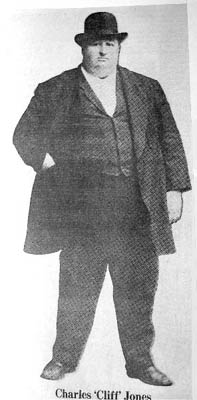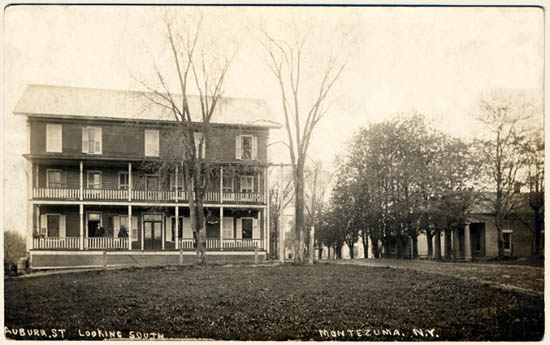|
Hotel Keeper Jones
Carried Much Weight in Montezuma
by
MONTEZUMA—Charles C. “Cliff” Jones, with all of his 426 pounds, was easy to get along with if you didn’t cross him.
For years, he ran the Clifford House, and, in fact, built it. In the early 1900s it was a popular get-away where all-night dances were held, with a ballroom on the third floor which was late removed. Many parties were also held there in the early days, including political rallies.

Charles C. “Cliff” Jones owned and operated the Clifford House in Montezuma
in the early 1900s.
It is
said he weighed 440 pounds.
Occasionally, there were troublemakers who drank too much. Cliff could run up two flights of stairs as good as anyone. He’d grab the fighters by the nape of the neck, sometimes one in each hand, bring them downstairs and thrown them out the big double doors.
Back in the horse and buggy days, Montezuma was a rough-and-tumble town on the Erie Canal, near the junction of the Cayuga and Seneca branch canal. There was another settlement a few miles north of Montezuma called “Charleston,” which also had a notorious reputation. But it couldn’t hold a candle to Montezuma—especially during the period of construction of the Barge Canal.

Early 1900s view of the Erie Canal looking west in the hamlet
of Montezuma.
At right is the old Exchange Hotel. Photo courtesy of Bill Hecht
of Union Springs
Frontier town atmosphere
Workers for the Kinzer Construction Co., a contractor for this portion of the canal, would flow into the hamlet at night, and especially weekends. The place took on the air of a Western frontier town. Saloons by far outnumbered churches and stores, and it wasn’t uncommon to occasionally fish a body out of the canal on a Sunday morning.
A story is told of Cliff Jones concerning his election as justice of the peace in February, 1901. The six-foot giant with a 67-inch waist and 24-inch collar, was going to Auburn to be sworn in. When he climbed into the stagecoach to go into town, the floor gave way, leaving him with his feet resting on the ground, trotting along at the same pace as the horses.
From this predicament he was rescued by jacking him back up inside the stage with planks and blocks of wood until he was able to lift himself back onto the seat. He was secured by shoring up the seat with bags of flour placed underneath. His nephew, Charles Jones, recalled that when he was a boy, his uncle took him for buggy rides “You wouldn’t know I was there unless you saw me get in,” he said.
The only way Cliff could climb into the buggy was by standing on a block or a stoop, put one hand on the dash and the other on the back of the seat, and heave himself in.
The Port Byron Chronicle once noted:
“Judge Charles C. Jones, of Montezuma, is probably the most ponderous jurist in the United States. He is six feet, one inch in height and weighs 440 pounds. Jones, who is proprietor of the Clifford House, is in good health, a jovial landlord and a radical Democratic leader in politics. His house is well patronized by transients curious to see the ‘big’ man.’"
Clifford House a ‘popular resort’
The Clifford House was a popular resort for canal boatmen and fishermen on weekends. “The warmth of Landlord Jones’ welcome and the geniality of his entertainment was equal to the immensity of his proportions,” one old-timer recalled.

The Clifford House in Montezuma in the early 1900s was a popular spot. particularly on Saturday nights. But its proprietor, Cliff Jones, did not tolerate too much roudiness, would quickly eject troublemakers from the premises.
Photo courtesy of Bill Hecht of Union Springs.
“There weren’t many cars around in those days,” his nephew said. “Sundays, especially during early fall, people came out from Auburn in carriages for dinner. He had a bar, of course. and he would get beer in barrels and serve it on draft. When I was 15 years old, I was down there with him all summer. Canal boats would bring in barrels a couple of times a week, and I remember rolling them three to four hundred feet from the canal up to the hotel.”
Mr. Jones died on July 4, 1906, after being ill for some time. It took four men to bring him down from the second floor, and they couldn’t even get the casket all the way through the big double doors to lay him out. He was only 47 years old when he died, and left a widow, Mary, but no children. The hotel was subsequently owned and operated by David Butler.
Charles Jones, son of Cliff’s brother, Washington, who ran a store in Montezuma, said, “You should have seen him when he used to get out on the dance floor and dance a square set. He was very light on his feet.” Charles was born in 1887 and lived in Macedon, near Palmyra, for many years, after retiring from the telephone company.
Although he left Montezuma in 1912, Charles had vibrant memories of his youth in this small, but robust community which was created as a result of the coming of the canal. He said he worked as a deckhand, oiler and fireman aboard the large dredge “Montezuma,” which was constructed near the old Richmond Aqueduct, a short distance away from the hamlet. The vessel was owned by the Kinzer Construction Co. and was launched in 1909.
Company went Bankrupt
Later, this company went bankrupt, and the contract to finish this portion of the canal between Montezuma and Mays Point went to James Stewart Co.
“I used to think I was born 50 years too soon,” Jones said, “but I’ve changed my mind.” He said he used to be able to buy a good pair of shoes for $4 and a blue surge suit for $15, including two pairs of pants and a vest.
In the days preceding the Barge Canal, “I’d get a can of worms, fishpole and a market basket and go down to the bridge and go fishing. You could catch sunfish, perch, rock bass and fill a basket in a couple of hours. They used to fish with nets for bullheads and ship carp to New York City.”
Good old days
Then there were the summer excursions to Cayuga Lake Park, baseball games at Union Springs, and Sunday school picnics at Sheldrake Point. But things changed over the years. Jones recalled that Montezuma is barely a shadow of what it once was. The bed of the old Erie Canal, long abandoned, sets in loneliness in the weeds and underbrush. The Clifford House is now closed, although it survived its creator by a little more than a century.
There are only memories and old postcard views to reflect upon a certainly more interesting and lively period, as the old timers used to say, “back when the world was young.”

The Clifford House in Montezuma as it appears today. The third floor, where the ballroom was once located,
was removed in the 1950s following a fire.
|